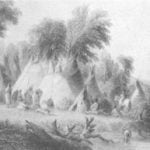The Wahpeton, “dwellers among leaves,” constitute one of the seven great divisions of the Dakota, and to quote from the Handbook: “Historic and linguistic evidence proves the affinity of this tribe with the Sisseton, Wahpekute, and Mdewakanton. Hennepin (1680) mentions them as living in the vicinity of Mille Lac, Minnesota, near the Mdewakanton, Sisseton, and Teton. On his map they are placed a little to the Northeast of the lake.”
While living in the seclusion of the vast forests which surrounded the great lakes of central Minnesota, the villages of the Wahpeton were probably formed of groups of bark or mat covered structures so typical of the region at a later day. Gradually they left the timbered regions, and about the first years of the last century were living near the mouth of the Minnesota River. Thence they appear to have moved up the stream, and during the summer of 1823 were encountered by the Long expedition in the vicinity of Big Stone Lake, in the present Lac qui Parle County, Minnesota.The account of the meeting with the Indians on the prairie, and later of their visit to the village, by the members of the expedition, is most interesting. On July 21, 1823. “While traveling over the prairie which borders upon this part of the St. Peter, that connects Lake qui Parle with Big Stone Lake, our attention was aroused by the sight of what appeared to be buffaloes chased across the prairie. They, however, soon proved to be Indians; their number, at first limited to two, gradually increased to near one hundred; they were seen rising from every part of the prairie, and after those :n advance had reconnoitered us, and made signals that we were friends, by discharging their guns, they all came running towards us, and in a few minutes we found ourselves surrounded by a numerous band. Some of them were mounted on horseback, and were constantly drumming upon the sides of their horses with their heels, being destitute both of whip and spur. Many of them came and shook hands with us, while the rest were riding all round us in different directions. They belonged, as we were told, to the Wahkpatoan, [Wahpeton] one of the tribes of the Dacotas. As we rode towards their lodges, we were met by a large party of squaws and children, who formed a very motley group. The village, to which they directed us, consisted of thirty skin lodges, situated on a fine meadow on the bank of the lake. Their permanent residence, or at least that which they have occupied as such for the last five years, is on a rocky island, (Big Island), in the lake, nearly opposite to and within a quarter of a mile of, their present encampment. Upon the island they cultivate their cornfields, secure against the aggressions of their enemies. They had been lately engaged in hunting buffalo, apparently with much success. The principal man led us to his lodge, wherein a number of the influential men were admitted, the women being excluded; but we observed that they, with the children, went about the lodge, peeping through all the crevices, and not infrequently raising the skins to observe our motion. They soon brought in a couple of large wooden dishes, filled with pounded buffalo meat boiled, and covered with the marrow of the same animal; of this we partook with great delight.” This was followed by another feast, in a near-by tent, and still a third where a dog had been killed and prepared, “which is considered not only as the greatest delicacy, but also as a sacred animal, of which they eat only on great occasions.” The party did not remain long at the village, but continued on up the lake shore, and soon encountered on a bluff “two Indian lodges, in one of which was Tatanka Wechacheta, (the buffalo man,) an Indian who claims the command of the Wahkpatoans.” Later in the clay the party returned to these lodges, where “the chief, and his principal men, were in waiting. We entered the skin lodge, and were seated on fine buffalo robes, spread all round: on the fire, which was in the centre of the lodge, two large iron kettles, filled with choicest pieces of buffalo, were placed. Our hosts were gratified and flattered at the quantity which we ate; the residue of the feast was sent to our soldiers. In this, and every other instance where we have been invited to a feast by Indians, we observed that they never eat with their guests.” 1

The village of skin-covered tipis standing on the shore of the lake, as seen by members of the expedition on that July day nearly a century ago, must have resembled the painting later made by Capt. Eastman, which is reproduced in plate 22b, taken from Schoolcraft. In the painting the tipis are undoubtedly too closely placed, but otherwise they are quite accurately shown. This illustration as used in Schoolcraft bears the legend ” Dakotah Encampment.”
Citations:

